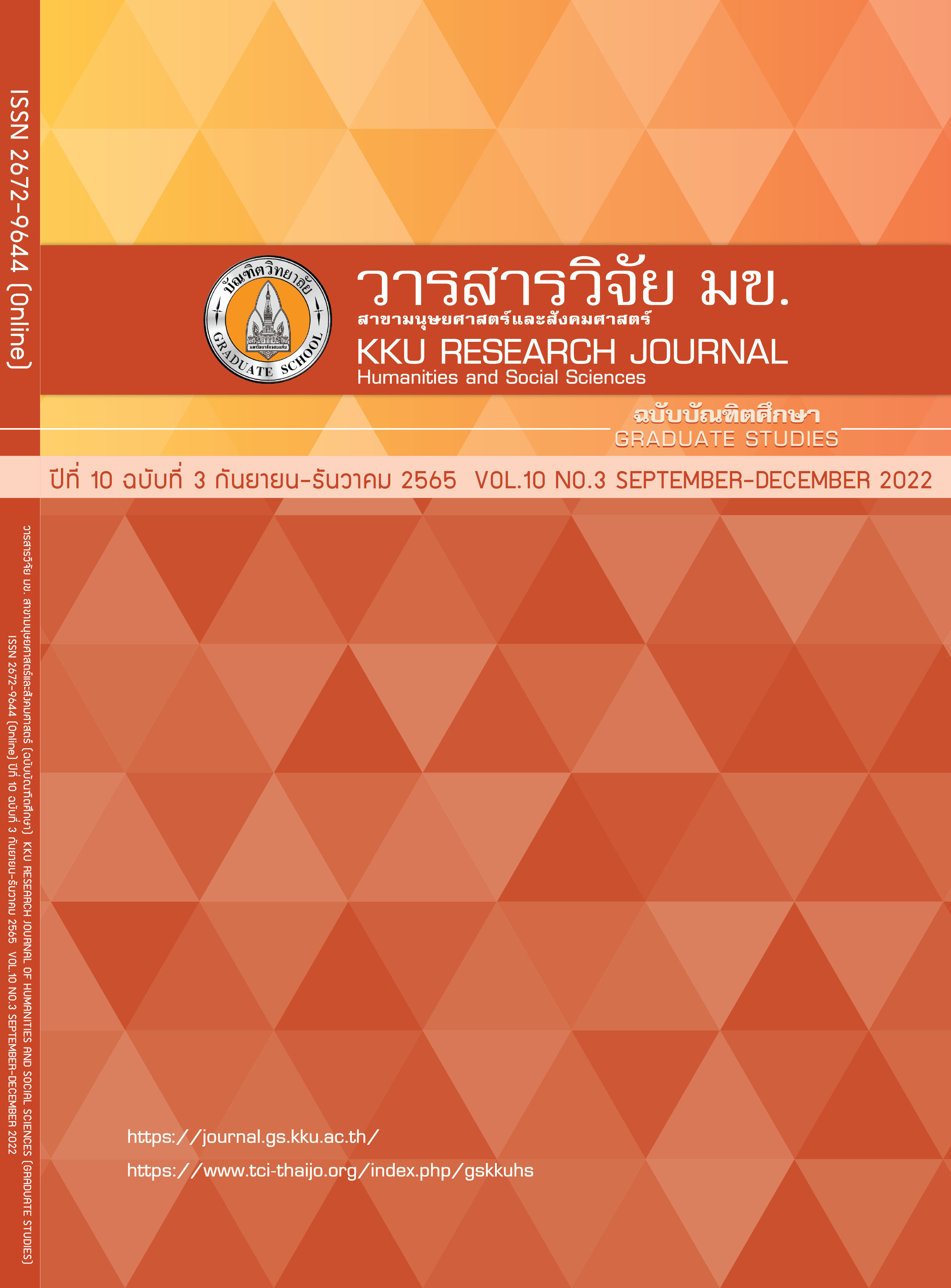การรับรู้ของผู้เรียนและอาจารย์วิศวกรรมศาสตร์ในระดับอุดมศึกษาไทยต่อการใช้ภาษาอังกฤษเป็นสื่อกลางในการสอน
คำสำคัญ:
English as a Medium of Instruction, Perception, Engineeringบทคัดย่อ
This study examined the perceptions of Thai Tertiary-Level Engineering students and lecturers using English as a Medium of Instruction (EMI). Two study questions were formulated. They were 1) What are the perceptions of Thai Tertiary-Level Engineering students and lecturers using English as a Medium of Instruction (EMI); 2) How do Thai tertiary-level Engineering students and lecturers use English as a Medium of Instruction. The data for this study was gained through using a questionnaire with a 5-rating scale and by conducting interviews. This study was carried out with two hundred fourteen Engineering students and sixty-five lecturers at one of the universities in Northeastern Thailand. To complete the data analysis, descriptive statistics were employed to analyze the quantitative data, while the qualitative data was explored using discourse analysis. The findings indicated that according to students’ perceptions, they felt that they had needed to study harder when required to learn a subject in English in the international program (x=4.46, S.D.= 0.67). Although it had been more difficult, the students were able to identify specific reasons for studying in the international program. Meanwhile, based on the lecturers’ perception figures, they believed that EMI could provide students with the skills necessary for a successful life in business after graduating from the university (x=4.48, S.D.= 0.68). Moreover, the lecturers argued that the study of Engineering requires a different level of English proficiency. Hence, EMI can help students to better prepare to acquire sufficient skills. The implication of the study is that the implementation of EMI could benefit students by providing them with learning experiences that could promote greater proficiency, which is needed in the workplace. Therefore, creating and conducting an EMI preparatory program for students and lecturers is an urgent matter. Such a program would allow them to become more qualified and would encourage them to better comprehend the specific purposes of learning by incorporating EMI.
เอกสารอ้างอิง
Wilkinson R. English-medium instruction at a Dutch university: Challenges and pitfalls. English-medium instruction at universities: Global challenges. 2013; 324(10.21832): 9781847698162-005.
Tang KN. Challenges and Importance of Teaching English as a Medium of Instruction in Thailand International College. Journal of English as an International Language. 2020; 15(2): 97-118.
Hazelkorn E. World-class universities or world-class systems? Rankings and higher education policy choices. Rankings and accountability in higher education: Uses and misuses. 2013: 71-94.
Phillipson R. Linguistic imperialism continued. [n.p.]: Routledge; 2013.
Dearden J. English as a medium of instruction-a growing global phenomenon. [n.p.]: British Council; 2014.
Jenkins J, Mauranen A. Studying linguistic diversity on English-medium campuses. Linguistic diversity on the EMI Campus. [n.p.]: Routledge; 2019. p. 3-20.
Griffiths EJ. English as a medium of instruction in higher education institutions in Norway: A critical exploratory study of lecturers’ perspectives and practices. [n.p.]; 2013.
Dafouz E, Camacho-Miñano MM. Exploring the impact of English-medium instruction on university student academic achievement: The case of accounting. English for Specific Purposes. 2016; 44: 57-67.
Lavankura PJJosiie. Internationalizing higher education in Thailand: Government and university responses. 2013; 17(5): 663-76.
Baker W, Hüttner JJIJoAL. “We are not the language police”: Comparing multilingual EMI programmes in Europe and Asia. 2019; 29(1): 78-94.
Bekteshi E, Xhaferi B. An Analysis of English for Specific Purposes among University Students. Educational Process: International Journal. 2020; 9(2): 90-102.
Atik E. Perceptions of students towards English medium instruction at tertiary level: the case of a Turkish private university: Middle East Technical University. [n.p.]; 2010.
Macaro E, Curle S, Pun J, An J, Dearden J. A systematic review of English medium instruction in higher education. Language Teaching. 2018; 51(1): 36-76.
Lasagabaster D. The relationship between motivation, gender, L1 and possible selves in English-medium instruction. International Journal of Multilingualism. 2016; 13(3): 315-32.
Le DM. English as a medium of instruction at tertiary education system in Vietnam. Journal of Asia TEFL. 2012; 9(2).
Trakulkasemsuk W. English in Thailand: Looking back to the past, at the present and towards the future. Asian Englishes. 2018; 20(2): 96-105.
Bunwirat N. English language teaching in AEC era: A case study of universities in the upper northern region of Thailand. FEU Academic Review. 2017; 11(2): 282.
Tashakkori A, Creswell JW. Exploring the nature of study questions in mixed methods study. Los Angeles, CA: Sage Publications Sage; 2007. p. 207-11.
Johnson RB, Onwuegbuzie AJ, Turner LAJJommr. Toward a definition of mixed methods study. 2007; 1(2): 112-33.
Dafouz E, Smit U. ROAD-MAPPING English medium education in the internationalised university. [n.p.]: Springer; 2020.
Yuan Y. Pragmatics, perceptions and strategies in Chinese college English learning. [n.p.]: Queensland University of Technology; 2012.
Srisa-ard B. Study for lecturers. Bangkok: Suweeviriyasarn; 2003.
Ahmad SZ. Evaluating student satisfaction of quality at international branch campuses. Assessment & evaluation in higher education. 2015; 40(4): 488-507.
Aizawa I, Rose H, Thompson G, Curle S. Beyond the threshold: Exploring English language proficiency, linguistic challenges, and academic language skills of Japanese students in an English medium instruction programme. Language Teaching Study. 2020: 1362168820965510.
Turhan B, Kirkgöz Y. Motivation of engineering students and lecturers toward English medium instruction at tertiary level in Turkey. Journal of Language and Linguistic Studies. 2018;14(1):261-77.
Vu NT, Burns A. English as a medium of instruction: Challenges for Vietnamese tertiary lecturers. Journal of Asia TEFL. 2014; 11(3).
Başıbek N, Dolmacı M, Cengiz BC, Bür B, Dilek Y, Kara B. Lecturers’ perceptions of English medium instruction at engineering departments of higher education: A study on partial English medium instruction at some state universities in Turkey. Procedia-Social and Behavioral Sciences. 2014; 116: 1819-25.
Galloway N, Numajiri T, Rees N. The ‘internationalisation’, or ‘Englishisation’, of higher education in East Asia. Higher Education. 2020; 80(3): 395-414.
Paseka A. Towards internationalisation in lecturer education: An attempt to use English as the working language in a sociology course. Teaching in Higher Education. 2000; 5(3): 359-71.
Cho DW. English-medium instruction in the university context of Korea: Tradeoff between teaching outcomes and media-initiated university ranking. Journal of Asia TEFL. 2012; 9(4).
ดาวน์โหลด
เผยแพร่แล้ว
รูปแบบการอ้างอิง
ฉบับ
ประเภทบทความ
สัญญาอนุญาต

อนุญาตภายใต้เงื่อนไข Creative Commons Attribution-NonCommercial-NoDerivatives 4.0 International License.




